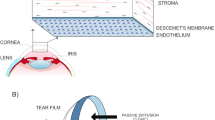Background: The human corneal endothelium has a limited proliferative capacity in vivo. Until now it has only been possible to replace damaged endothelium by transplantation of a donor cornea. After establishing methods for the isolation and in vitro cultivation of human corneal endothelial cells, transplantation of these cells my be an alternative therapeutic option.
Materials and methods: In this review methods for the in vitro cultivation of human corneal endothelial cells and their transplantation on the Descemet membrane of donor corneas are described.
Results: In vitro proliferation of human adult corneal endothelial cells was achieved by the development of defined cell culture conditions, including supplementation of culture medium with specified growth factors and substances. Dependent on the culture conditions, as well as independent of them, in vitro cultured endothelial cells showed phenotypic changes and different proliferative behavior. Thus, molecular biological examinations revealed a different expression pattern of growth factor receptors in fibroblast-like endothelial cells (dedifferentiated) compared to typical endothelial cells (differentiated). Moreover, the proliferative capacity of the cells differed, dependent on their corneal location. Cells isolated from the peripheral part of donor corneas have a higher proliferative capacity than cells obtained from the central part. The propagation of corneal endothelial cells in vitro offered the possibility of their transplantation on donor corneas in an in vitro model. After transplantation, these cells formed a monolayer whose morphology and cell density depended on the differentiation of the cells. DNA synthesis was predominantly detectable in cells of the corneal periphery.
Conclusions: Our findings are the basis of the following hypothesis: the periphery of the cornea represents a regenerative zone of the corneal endothelium. The fact that early after transplantation corneal endothelial cells form a monolayer on the natural extracellular matrix (ECM), which shows contact inhibition, suggests that inhibitory factors are released by the Descemet membrane that influence the proliferation of the cells. Further studies on the regulation of the proliferation and differentiation of human corneal endothelial cells in vitro and after transplantation might offer the possibility to establish a selective procedure for the treatment of corneal endothelial cell loss in the near future.
Hintergrund: Das humane korneale Endothel ist in vivo nur eingeschränkt teilungsfähig und geschädigtes Endothel kann bisher nur durch die Transplantation einer Spenderhornhaut ersetzt werden. Die Transplantation von isolierten und in-vitro-kultivierten Endothelzellen könnte zukünftig eine therapeutische Alternative darstellen.
Material und Methode: Beschrieben werden die Verfahren zur Kultivierung von humanen kornealen Endothelzellen und eine Methode zur Transplantation dieser Zellen auf die Descemet'sche Membran von Spenderhäuten in vitro.
Ergebnisse: In vitro kultivierte Endothelzellen wiesen kulturabhängige, aber auch unabhängige phänotypische Veränderungen und unterschiedliches Proliferationsverhalten auf. Untersuchungen auf molekularbiologischer Ebene zeigten, daß fibroblastische (dedifferenzierte) und endothelähnliche (differenzierte) Endothelzellen ein unterschiedliches Expressionsmuster für Rezeptoren von Wachstumsfaktoren aufwiesen. Weitere Untersuchungen deuteten darauf hin, daß Endothelzellen, die von der Randzone von Spenderhornhäuten isoliert wurden, eine stärkere Proliferationskapazität besitzen als zentral isolierte Zellen. Die Vermehrung der Endothelzellen in vitro ermöglichte die Transplantation der Zellen auf Spenderhornhäute in einem In-vitro-Modell. Nach Transplantation bildeten diese einen Monolayer aus, dessen Morphologie und Zelldichte von der Differenzierung der Zellen abhängt. Die DNS-Synthese war vorwiegend in Zellen der Hornhautperipherie feststellbar.
Schlußfolgerung: Die Hornhautperipherie scheint eine regenerative Zone für das korneale Endothel darzustellen. Die auf der natürlichen Matrix (ECM) nach der Transplantation früh einsetzende Ausbildung eines Monolayers mit Kontaktinhibition weist auf zusätzliche inhibitorische Faktoren aus der Descemet'schen Membran hin, welche die Proliferation der Zellen beeinflussen. Weitere Untersuchungen zur Regulation der Proliferation und Differenzierung humaner kornealer Endothelzellen in vitro und nach Zelltransplantation könnten dazu führen, in naher Zukunft ein selektives Verfahren zur Behandlung von kornealen Endothelzellverlusten zu etablieren.
Similar content being viewed by others
Author information
Authors and Affiliations
Rights and permissions
About this article
Cite this article
Engelmann, K., Bednarz, J. & Böhnke, M. Endothelial cell transplantation and growth behavior of the human corneal endothelium. Ophthalmologe 96, 555–562 (1999). https://doi.org/10.1007/s003470050452
Issue Date:
DOI: https://doi.org/10.1007/s003470050452




